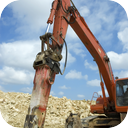(short preview of full seamless looping track)
(short preview of full seamless looping track)
(short preview of full seamless looping track)
(short preview of full seamless looping track)
(short preview of full seamless looping track)
Large Construction Drilling
This product is not available in the selected currency.
In Stock
Backordered
Out of Stock
Description
The dust particles spew from the crushed rock hole where this enormous industrial drill carves a tiny cavern out of the earth. On the surface, we hear the great roar of modern machinery building our great modern age, but below, where the little earth dwelling critters hide in their tunnels, it is as if the entire world were turning upside down, and the very foundations of a million year-old reality were being scratched right out of existence. The earliest drills were bow drills which date back to the ancient Harappans and Egyptians. The drill press as a machine tool evolved from the bow drill and is many centuries old. It was powered by various power sources over the centuries, such as human effort, water wheels, and windmills, often with the use of belts. With the coming of the electric motor in the late 19th century, there was a great rush to power machine tools with such motors, and drills were among them. The invention of the first electric drill is credited to Arthur James Arnot and William Blanch Brain, in 1889, at Melbourne, Australia. Wilhelm Fein invented the portable electric drill in 1895, at Stuttgart, Germany. In 1917, Black & Decker patented a trigger-like switch mounted on a pistol-grip handle. There are many types of drills: some are powered manually, others use electricity (electric drill) or compressed air (pneumatic drill) as the motive power, and a minority are driven by an internal combustion engine (for example, earth drilling augers). Drills with a percussive action (hammer drills) are mostly used in hard materials such as masonry (brick, concrete and stone) or rock.
This sound uses the following file from Freesound: http://www.freesound.org/samplesViewSingle.php?id=127173
Opps
Sorry, it looks like some products are not available in selected quantity.



